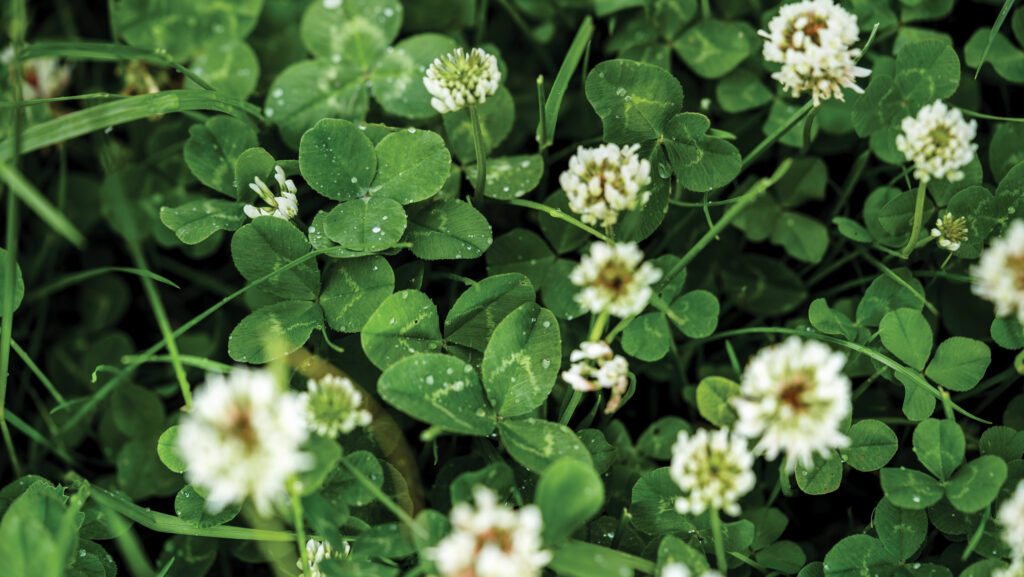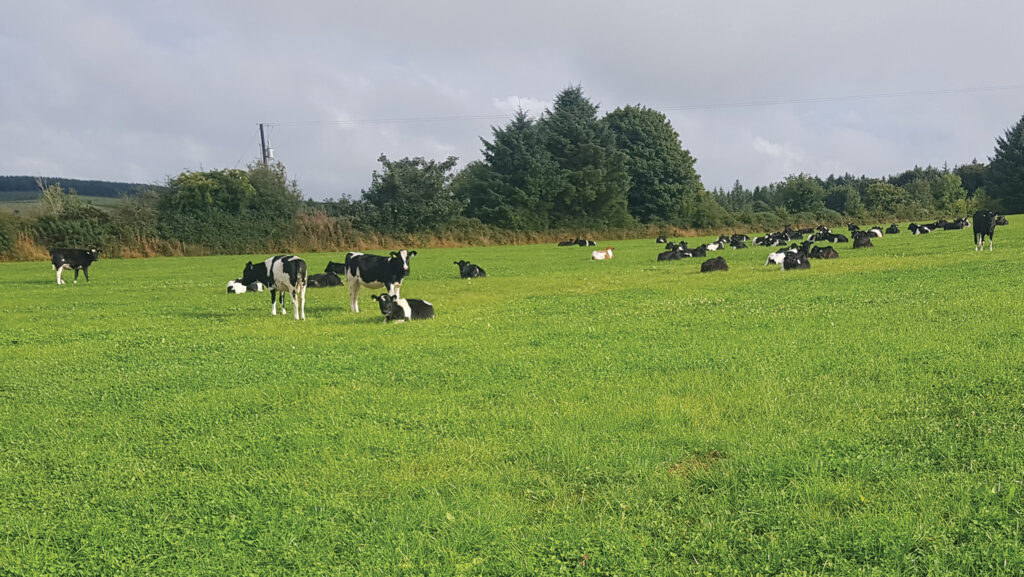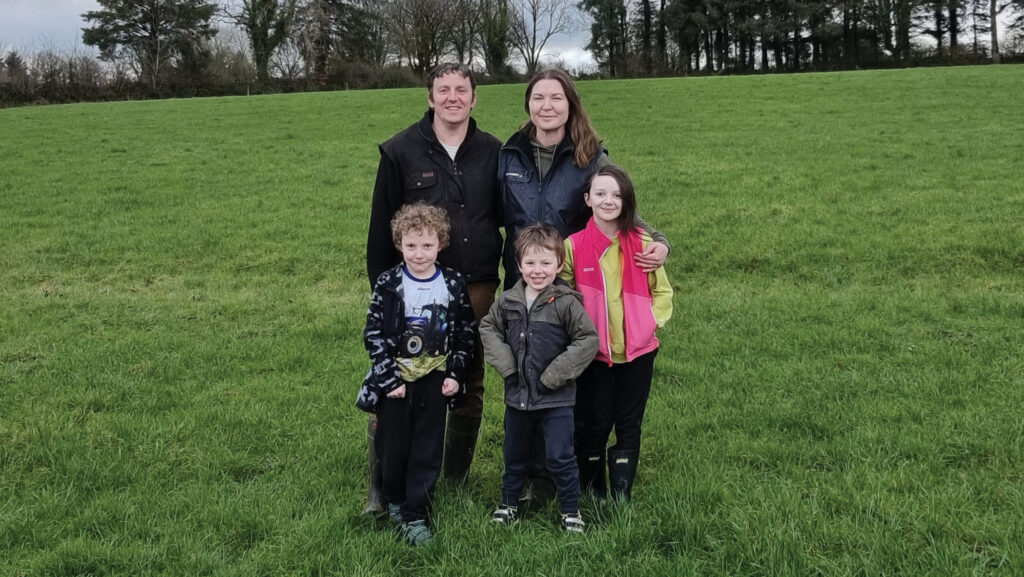How an Irish dairy unit is using clover to target zero N
 © Germinal
© Germinal A good grass-growing farm – albeit one at altitude – has been gradually incorporating clover into its leys as part of its low-nitrogen grazing system.
As a result, Bryan and Gail Daniels have been able to halve their artificial nitrogen (N) inputs, further cutting their milk production costs, at Raheenarran in County Kilkenny, Ireland.
See also: Tips for establishing white clover in a sward
Although they can average 16.8t of dry matter a hectare and graze for 10 months of the year, their 157ha (388-acre) business has persevered with sowing and growing this legume in both grazing and silage swards.
“It reduces our emissions by cutting chemical nitrogen usage and increases animal performance from high dry-matter swards,” says Bryan, adding that their recent carbon footprint, of 0.72kg of carbon dioxide equivalent for each 1kg of fat- and protein-corrected milk, puts them in the top 10% of Irish farms.
Lying 270-305m above sea level, Bryan says the farm’s 1,200mm annual rainfall in a level supply means it grows grass well.
“We have the south-west sea breeze to keep it warm and it very seldom drops growth,” he says.
“Grazing is from when cows calve in the first week of February until housing in the first week of December. It’s a good, long season.”
Soils are base shale rock going into deep blue clays, while some brown podzolics hold moisture.
“We have good infrastructure on paddocks – tracks made from base shale we dig ourselves on the farm – with multiple gateways and on/off grazing if it turns wet,” he explains.

© Bryan Daniels
Controlling input costs
With a 270-cow spring block-calving herd and a focus on rotational grazing, the couple had already made steps to control costs.
Adding clover was a way to reduce N inputs when farming within milk quotas. But two very wet and cold summers in 2009 and 2012 meant clover “did not work”, says Bryan.
By 2018, he had given up on it, resorting to using his full N allowance of 220kg/ha.
Some excellent growing years for clover, in 2019 and 2020, saw the plant re-establish itself in a few paddocks.
Since then, he has actively been including it across the farm. Learning from his mistakes, Bryan says he set about creating the right conditions to support the plant, managing it to optimise N production, gaining the confidence to reduce N inputs and understanding how to prevent bloat.
Some 28% of the farm’s grassland (21% in a poor year) is now run under what he calls a “zero-N” system, relying on clover to fix N for grass growth.
There are strategic applications of slurry and artificial fertiliser where – and when – needed, according to percentage of clover cover and soil temperature.
“We always have to be prepared to adjust,” he says.
“Clover is active from 8C but starts to properly fix N at 10C. Last year was also a cold, wet summer following a cold, late spring.
“Soil temperatures were 1-1.5C lower, so we spread more N than our three-year average, although still only used 142kg/ha. We spread 104kg in 2023.”
Farm facts: Raheenarran, County Kilkenny, Ireland
- 65ha owned and 92ha rented – all grass including 93ha cow platform
- 270 British Friesian cows
- 20% replacement rate
- Production of 440-470kg milk solids
- Farm stocking rate 2.4 livestock units/ha
- Paddock dry matter yields range from 7t/ha on natural meadows to 22t/ha on three grazing/three cuts of silage
Clover basics
The starting point for successful clover management, says Bryan, is having good soil fertility and getting the minimum pH of 6.5.
“We spread 60-80t of lime on the farm each year. My soil types are OK for potassium, but I’ve got to watch phosphorus.”
He samples one-third of the farm’s soils each year, topping up nutrients according to the results, as well as considering stocking rates and nutrient take-off.
This is helped by plate metering 30 times a year to record grass growth. Slurry is applied via a trailing shoe in spring at 28cu m/ha, depending on soil test results, to build fertility and organic matter.
White clover varieties are chosen from the Irish recommended list for tonnes of yield; spring, summer and autumn growth rates; and persistency under rotational grazing, together with complementary grasses suited to zero N.
“The vast majority I pick have medium-sized leaves, as this gives the best balance between animal performance on grazing and nitrogen fixed,” Bryan explains.
Last year, he used Germinal’s Aberherald and Aberlasting varieties and is now looking at a hybrid of red and white clovers to improve persistency on the stolon (to reduce plant damage from grazing), plus the higher N fixing of red clover.

Bryan and Gail Daniels with children Toby, Eli and Shannon © Bryan Daniels
Scoring clover cover
To set up zero N, and target fertiliser, Bryan walks his fields early in the year and scores the clover percentage of each paddock.
By mid-April, any with more than 20% clover are started on the zero N system: no early nitrogen, but dairy washings applied throughout summer and early autumn.
“Because of our altitude, we are later than lowland farms and don’t see clover fixing N until the end of April.
“From mid-April to the first week of May, I compare grass growth rates. Fields with less than 15% of clover get N. Also, clover content in a paddock must be uniform, not patchy.
“Any gaps are given nitrogen to get going – usually 62-125kg/ha of urea.”
Bloat was not a problem until last year. Bryan found two dead cows one day and thinks it was because the farm had grown lower levels of clover.
This meant the diet was inconsistent, grazing for three to four days without clover, then going back to it.
At the end of summer, clover cover can be as high as 30-40%, but the sweet spot is to have more than 25% of the farm, he says.
The rotary parlour now dispenses 20ml of bloat oil onto concentrates at every milking.
Youngstock management
Bryan finds youngstock reared on clover swards go on to have lower levels of bloat incidence as mature cows.
He sees no discomfort or bloat in his own heifers (born in the first three weeks of the calving block), which first have access to grazing from 17 March.
Managing bloat risk requires flexibility and vigilance, he stresses.
He is trying to grow more bird’s-foot trefoil, which can already be found in his meadows, for its tannins.
These compounds naturally prevent bloat by allowing cattle to self-medicate.
At the end of the grazing season, Bryan says it is important to make sure not too much grass is carried over winter.
This suffocates clover for the following season – light is needed in the sward base.
“Once everything is in its favour, clover takes off. If you can step on a plant every time you walk in a paddock, you have the potential to go zero N with clover.
“Go at half-rates and try it – see how it goes with skipping N applications.”
The numbers
400kg concentrates a cow
0.72kg of carbon dioxide equivalent a kilo of fat- and protein-corrected milk
18t dry matter a hectare yield on a zero-N field
